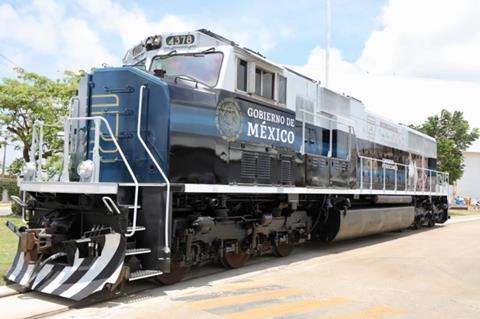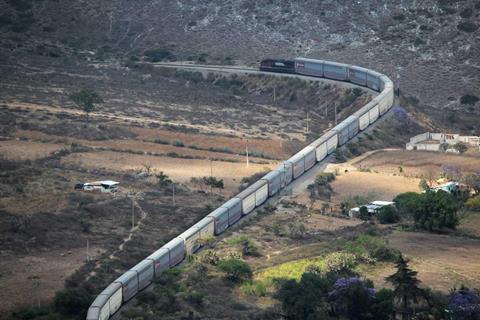
MEXICO: On November 20 the national government published legislation to introduce passenger rail services on seven corridors totalling 8 000 km to serve as what it called ‘the backbone of the Sistema Ferroviario Mexicano’.
The presidential decree signed by Andrés Manuel López Obrador also says that the concessionaires currently operating freight traffic on the routes in question have priority in presenting the required passenger service proposals; these are to be submitted to the government by January 15 2024. The proposals are expected to include an investment plan for making the various lines fit to handle passenger services, as well as indicative timescales for the work. The government says that the concessionaires are as a minimum expected to ‘express their acceptance and interest to co-operate in the establishment of the passenger services’.
If a concession holder fails to meet the January deadline, the Ministry of Infrastructure, Communications & Transport has the option to grant rights to operate passenger services to a third party. These could include the defence and naval ministries, which already manage two railway projects. The trans-isthmus rail corridor, which links the Pacific Ocean and Gulf of Mexico, is being rehabilitated under the Tren Interoceánico programme and is scheduled to open on December 22. The other is the Tren Maya programme, the first section of which is scheduled to open on December 15. Expressions of interest from other entities may also be sought, the government said.
The decree also states that on the routes in question, priority must be given to passenger services over freight. It says that, on most of the routes, stations closed in the mid-1990s when nationwide passenger services ceased are expected to be renovated and reopened.
Seven lines and 8 000 km
The document identifies seven lines where passenger services would be restored, totalling 8 000 route-km. Six of these are currently operated as freight railways under concessions held by Canadian Pacific Kansas City de México and Grupo México Transportes. These two holding groups together account for 81∙5% of the main line network.

These six lines all had passenger services until 1995, when the Mexican government auctioned off loss-making Ferrocarriles Nacionales de México routes to private concessionaires. The winning bidders sought to use the lines exclusively for freight, quickly leading to the end of passenger provision.
- The first route would link the Mexico City to Veracruz and Coatzacoalcos on the east coast. It would run on tracks managed by CPKC on the Mexico City – Veracruz section, and by GMT’s Ferrosur subsidiary on the Veracruz – Coatzacoalcos section. The line between Medias Aguas and Coatzacoalcos is already run by the military-backed Ferrocarril del Istmo de Tehuantepec, after GMT agreed to cede control last year in exchange for an extension of Ferrosur’s concession term.
- The second is the north-south Mexico City – Querétaro – Leon – Aguascalientes route, which would run on tracks shared by GMT’s Ferromex and CPKC.
- The third would be a link from Irapuato to Manzanillo on the west coast via Guadalajara and Colima. This line is currently managed under concession by Ferromex.
- The fourth route would run from Mexico City to Nuevo Laredo in the northeast, via San Luis Potosi and Monterrey. This route is operated and maintained by CPKC.
- The fifth corridor would link Mexico City with Nogales on the border with the USA, running along the west coast via Querétaro, Guadalajara, Tepic and Mazatlan. This line is managed by Ferromex.
- The sixth proposed route is the line through the centre of the country from Aguascalientes via Chihuahua to Ciudad Juarez on the border with the USA. This is also managed by Ferromex.
- The seventh route would connect Felipe Ángeles international airport and Pachuca. This service would be created as part of a new concession and would form a suburban rail corridor between Pachuca and Mexico City.
Reaction
On November 17, before the formal publication of the government’s legislation, CPKC de México issued a statement saying that it had reached an agreement with the government to perform a study into launching passenger services on the Mexico City – Querétaro line. It says it will also work closely with the government to evaluate the introduction of a passenger service on the San Luis Potosí – Monterrey – Laredo corridor.

CPKC said that the decree ‘emphasises that public freight rail services will be respected’, therefore the company does not expect an adverse impact on its concession rights. The Class I railroad also stressed its ‘extensive experience hosting passenger rail services in multiple locations across its network in the United States and Canada while efficiently managing freight service’.
Election looming
Rail investment has formed an important pillar of President Obrador’s ‘4T’ (Fourth Transformation) programme, which has a strong focus on infrastructure development. Most high-profile of these initiatives has arguably been the Tren Maya scheme in the southeast of the country, under which a rail link is being developed to serve the tourist hub of Cancún.
Obrador took office in 2018, and Mexico is due to hold a general election in June 2024.
- Subscribers can read more about the Mexican government’s rail investment programme in the August 2023 issue of Railway Gazette International.

















